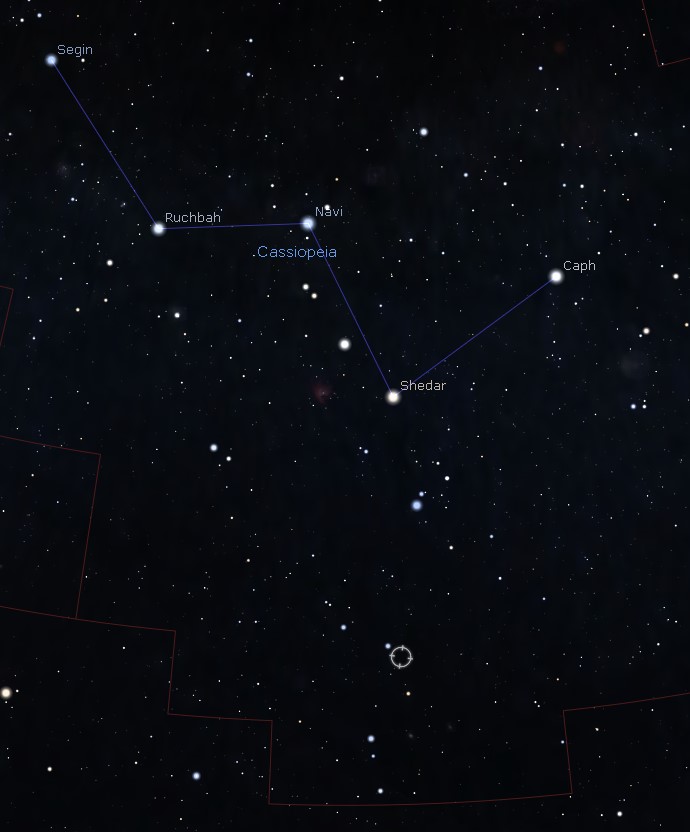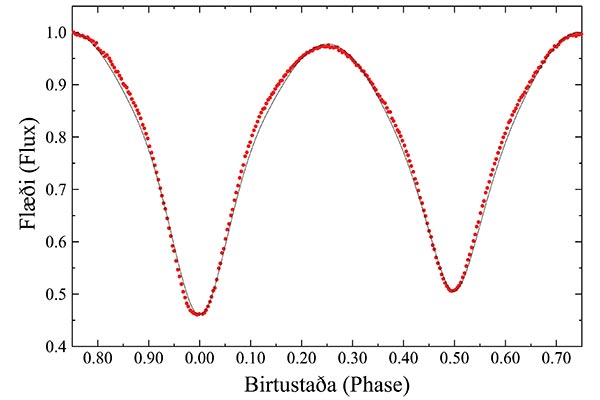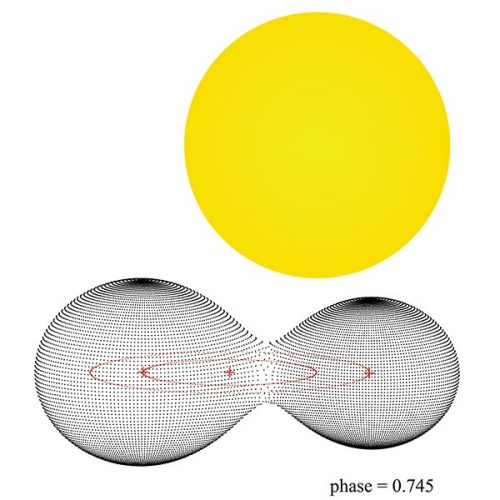Myrkvastjarnan V 523 Cas er snertitvístirni, staðsett 0,4 gráðu suðvestan við Xi (ξ) Cassiopeiae. Sú hefur notið nokkurrar athygli, m.a. vegna talsverðra tímafrávika í umferðartíma. Weber (1957) benti fyrst á birtusveiflu en taldi hana myrkvastjörnu af sömu gerð og Algol. Haussler (1974) birti fyrstu mæligildi um umferðartíma og birtulotu. Þau hafa verið endurskoðuð í áranna rás. Stjarnan er talin í 250 ljósára fjarlægð. V 523 Cas er með afar stutta birtulotu. Sínussveifla er í umferðartíma, sem bendir til þess að óséð þriðja stjarna sé í kerfinu. B.R.N.O. gagnagrunnurinn metur vægi mælinga lítið eða 1/10. Hún er skráð í gagnabanka Suhora stjörnustöðvarinnar og þar má nálgast upplýsingar um spáða myrkva.
V 523 Cas, positioned at 06 59 48.4 +27 41 58.7 (J 2000.0) is a short period (7h53m) contact eclipsing binary of visual mag. 9.8-9.92. V 523 Cas is an overcontact eclipsing binary that consists of two dwarf stars (color index K4V / K4V) and is defined as W type, which means the surface temperature of the smaller star is higher. Its period is amongst the shortest known and the star is noted for variations in the light curve and changes in the period. Samec et al. (2004) used 567 eclipses covering a period of 102 years and discovered a sinusoidal variation that indicates a third star member with a mass of 0.41 Mʘ. A study by Castelaz (2014) supports the existence of a third star in the system.

Staðsetningarkort fyrir V 523 Cas (Stellarium) – Location map of V 523 Cas (Stellarium).
Höfundur vefsvæðisins ljósmældi V 523 Cas nokkrum sinnum á árabilinu 2012–2014 og endurtók mælingar árið 2020. Niðurstöðurnar voru notaðar til þess til að meta birtulotu og birtustöðu (mynd 2) en þær leiddu einnig í ljós óreglu í brautartíma stjörnunnar. Að auki voru niðurstöðurnar notaðar í líkan af stjörnukerfinu (mynd 3) en til þess voru notuð mælingagögn frá D. Dunlap stjörnustöðinni í Kanada. Ýtarlegar er gerð grein fyrir mælingunum í samantektum yfir stjörnuathuganir frá Hornafirði árin 2013-2016 og 2020 en kaflarnir hafa verið dregnir saman og má nálgast hér.
Observation of V 523 Cas was made in 2012-2014 and repeated in 2020. The intention was to examine the period and O-C graph and use the results and radial velocity data, obtained by the D. Dunlap Observatory in Canada, to make a model of the binary. Due to the fact that the V 523 Cas is rather bright, the decision was taken to try using an 80 mm lens telescope. Besides it yields satisfactory results, there is no doubt a larger telescope is a better choice for such measurements. The results from 2020 (here) strongly indicate light fluctuation at maximum, most likely occurring on the star’s surface, in the photosphere or chromosphere, possibly a stellar flares. It is probable that star spots cover a small part of the surface of this pair, and this had to be taken into consideration for the model. Magnetic disturbances and starbursts are well-known events on EW binaries.

Mynd/Fig. 2. Birtustöðurit V 523 Cas. Birtustaða (phase) á þverás og birtustig á lóðás. – A phase diagram of V 523 Cas. Phase on x-axis and flux on y-axis.

Mynd/Fig. 3. Rúmfræðilegt líkan lýsir hjúpsnertistjörnu. Rauðir krossar eru massamiðjur og samþungamiðja kerfisins, rauðir hringir brautarferlar. Sólin (gul skífa) er sett til stærðarsamanburðar. – Geometrical model indicate a overcontact binary. Red crosses pinpoints center of masses and barycenter of the system. Red circles are supposed orbits around the barycenter. The Sun (yellow disc) is applied for size comparison.